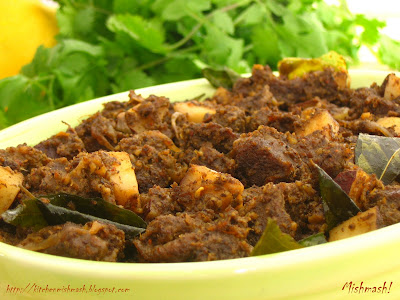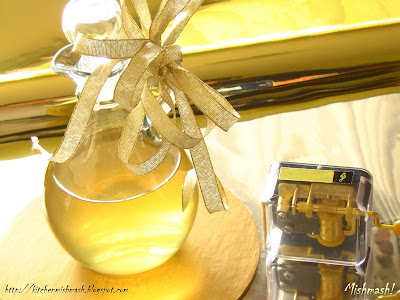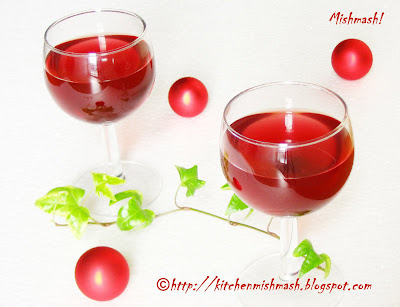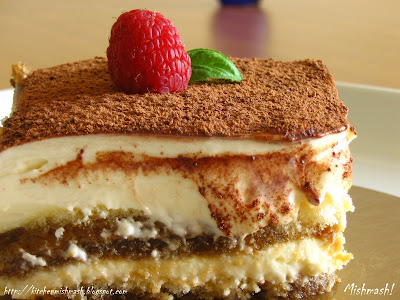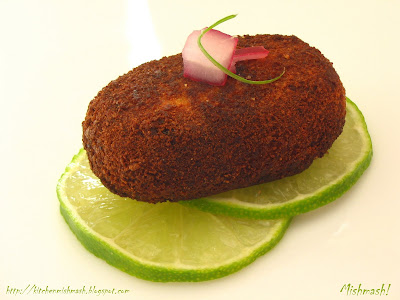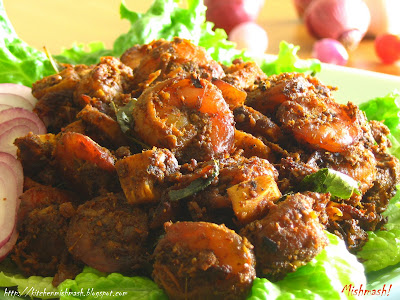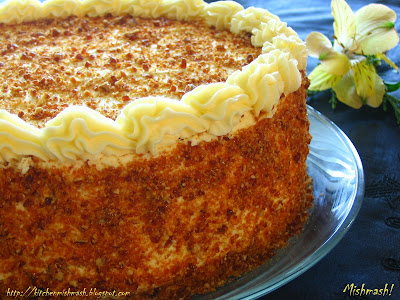

I know there is a general impression that this is predominantly a non-veg blog, even though I try to point my fingers to the vegetarian recipes I have blogged; (Yes, please do check out the recipe gallery, you can find a lot of vegetarian recipes) unfortunately, the desserts and the cakes & cookies are not considered vegetarian either!! For the same reason, I always admire and appreciate all my fellow bloggers, who are core vegetarians, who visit my blog and drop encouraging comments each and every time I publish a post. Even when it is a non-veg delicacy, they pour words of appreciation on the little notes in the introductory section or on the presentation of the dish or share some of their experiences and sometimes wonder about the substitutions they can make to vegetarianize the recipe or simply come and drop a hello! For a change, the whole of last week, my comment section witnessed a reverse trend after posting the recipe for Potato Stew; there were enquiries asking for the meat substitute, “ …. I tried the stew and it came out well. Can I substitute chicken for the veggies next time?” and some wondered “….Shn,eshtu looks delicious ,but desperately hope those potatoes were replaced by some chicken or mutton ! ".This is exactly the reason why I noted in my last post that generally carnivores like us don’t prefer the vegetarian version of many of the traditional Kerala delicacies though Potato Stew is an exception. Beef stew is the non-vegetarian take on the potato stew and is traditionally served with Palappam ( Kerala’s laced rice pancakes, shown in the picture) and its equivalents are chicken stew and mutton stew, delicacies a typical Keralite would die for. Cooked beef and potatoes stewed in rich coconut milk and flavored with whole spices and fresh herbs is a rich, thick and creamy dish whose first love is Palappam, at the same time ready to have a date with white bread or Idiyappam (Kerala’s string hoppers) or Chappathi (flat Indian bread).  Ingredients:(Approx.)
Ingredients:(Approx.) - ½ kg beef (Around 1 lb), cleaned and cut into small bite size pieces
- 1 small potato
- 4 cloves of fresh garlic, finely chopped (around 2 tbsp)
- 1 tbsp + 1tbsp finely chopped ginger
- 5 + 9 Indian green chillies split open lengthwise
- 2 sprigs of curry leaves
- 1/4 - 1/2 tsp freshly crushed pepper powder
- 2 tbsp oil, preferably coconut oil
- 4 small ½ inch pieces of cinnamon 4 cloves
- 3 cardamoms
- 2 bay leaves
- 1 large big onion thinly sliced
- 1 - 1 ¼ cups thin coconut milk/Randaampaal
- ¾ cup thick coconut milk/Thanipaal
- Salt to taste
Directions:
- In a pressure cooker, cook beef cut into small bite size pieces, finely chopped garlic, 1 tbsp finely chopped ginger, 5 green chillies and salt & pepper powder together, until it’s cooked well and beef turns tender and soft. Note: There is no need to add water while pressure cooking the beef as the meat is moist and will produce some water while cooking but if you are scared of safety issue of pressure cooker, you may add ¼ cup of water.
- Chop the potatoes into small pieces and microwave or boil the potato with a pinch of salt till it is cooked and when warm enough to touch, peel off the skin from the potato.
- In a large deep bottom pan, heat oil, throw in the whole spices like cloves, cinnamon, cardamom and bay leaves and let it fry in oil for 30 seconds. Add the thinly sliced big onions, 1 tbsp finely chopped ginger, green chillies and 1 sprig of curry leaves and cook until they turn soft and transparent. To this add the cooked beef mix well and then add the cooked potato cubes and combine well. Add thin coconut milk and salt and let it cook covered in low heat, for around 10-15 minutes. Now add the thick coconut milk and in medium heat, bring it to a boil and immediately reduce the heat, until it reaches a creamy and thick stew consistency. Just before turning off the stove, add rest of the curry leaves for the flavour and fragrance and stir well.
- Serve with Palappam/white bread/Idiappam/chappathi. Taste better after 2 hours from cooking.
Notes: Stew prepared in fresh coconut milk tastes better but I generally use canned coconut milk for the ease of cooking and they taste good. If you are using canned coconut milk, do add water to dilute it, even if you are preparing thick coconut milk. Also I prefer using golden big onions, rather than the red ones; it's a personal choice. The colour will be slightly different than the potato stew as we re using red meat here. You may add 1/4 - 1/2 tsp home made masala powder/garam masala towards the end , to have more flavour and smell; this is again a personal choice, depending on the taste and flavor one is looking for; at my place, we are happy with the whole spices alone, but if that is not satisfactory to you, feel free to add a pinch of homemade garam masala towards the end. Those who don't eat beef, can replace the meat with chicken and follow the same procedure.You get a better colour for Chicken stew, compared to beef stew.
My vegetarian friends, please help yourselves with Potato Stew :)
Update: You may try this dish with Paalappam.
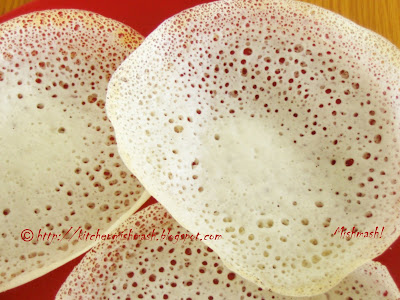
Luv
Shn



